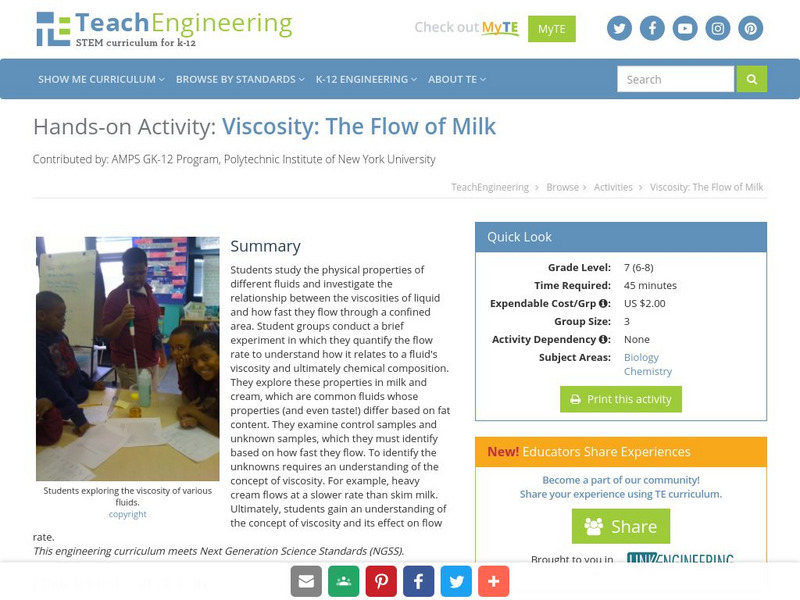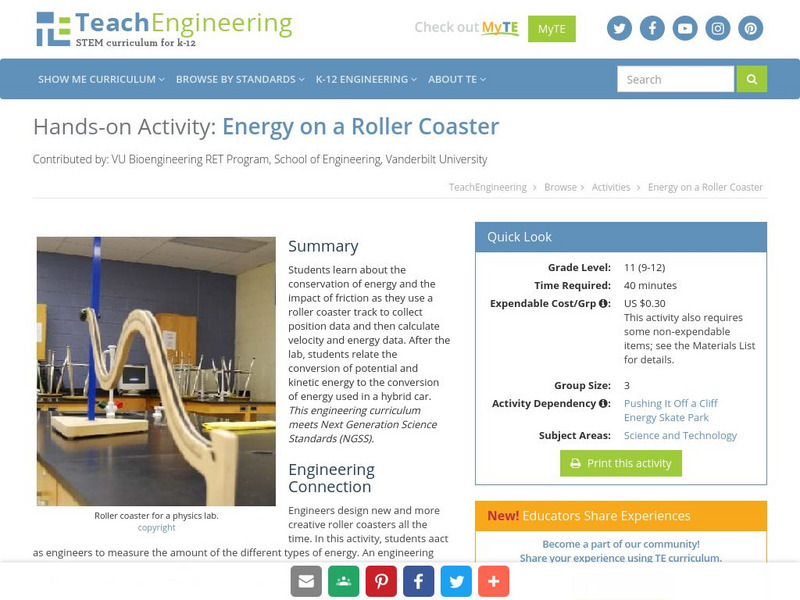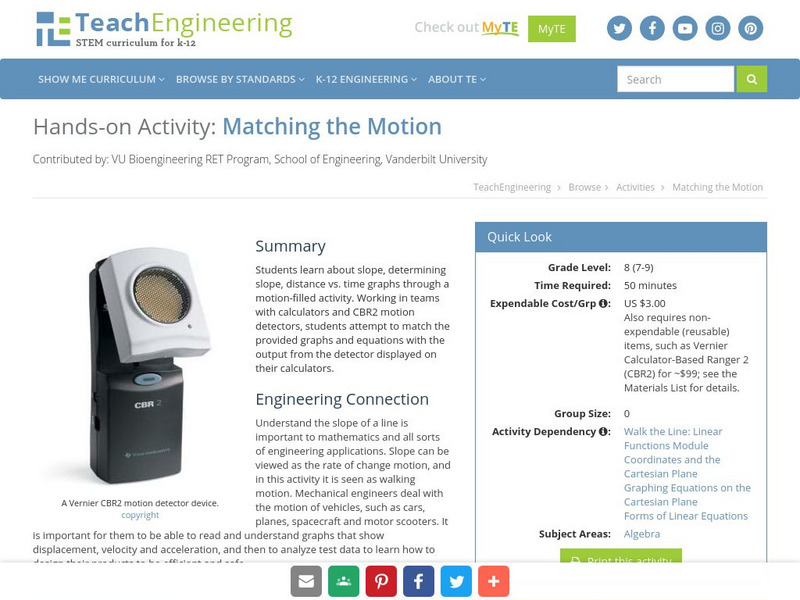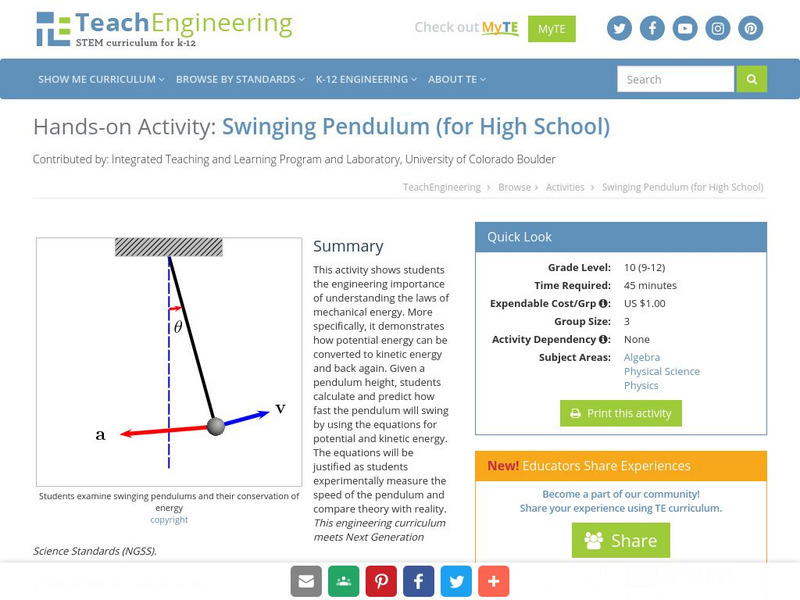TeachEngineering
Teach Engineering: Viscosity: The Flow of Milk
Students study the physical properties of different fluids and investigate the relationship between the viscosities of liquid and how fast they flow through a confined area. Student groups conduct a brief experiment in which they...
Science Museum, London
Science Museum: Online Stuff: Babbage
Charles Babbage is regarded as the first computer pioneer and originated the concept of a programmable computer. This biography details his accomplishments as a mathematician, philosopher, inventor and mechanical engineer
TeachEngineering
Teach Engineering: Circuits and Magnetic Fields
In this activity, students use the same method as in the activity from lesson 2 to explore the magnetism due to electric current instead of a permanent magnet. Students use a compass and circuit to trace the magnetic field lines induced...
TeachEngineering
Teach Engineering: Energy on a Roller Coaster
This activity utilizes hands-on learning with the conservation of energy and the interaction of friction. Students use a roller coaster track and collect position data. The students then calculate velocity, and energy data. After the...
TeachEngineering
Teach Engineering: Matching the Motion
Students learn about slope, determining slope, distance vs. time graphs through a motion-filled activity. Working in teams with calculators and CBL motion detectors, students attempt to match the provided graphs and equations with the...
Cosmo Learning
Cosmo Learning: Physics 240: Science and Engineering I
A collection of video lectures from a physics for science and engineering course taught at the University of Missouri-Kansas City. The course discusses the concepts of mechanics, wave motion, sound, heat and thermodynamics in thirty-five...
TryEngineering
Try Engineering: Heart of the Matter
Students learn about artificial heart valves and the engineering design process used in mechanical heart valve designs. The objective of the lesson is to develop an understanding of the interface between man and machine and the impact of...
National Academy of Engineering
Greatest Achievements: Agricultural Mechanization
This page details the mechanization of agriculture from the late 1800's to the late 1900's.
Government of Alberta
Alberta Human Resources and Employment: Oc Cinfo: Aircraft Maintenance Engineer
A video [4:48] overview of responsibilities of Aircraft Maintenance Engineer including: duties, working conditions, personal characteristics, education, and salary.
Michigan Technological University
Michigan Tech: Materials Science and Engineering: Tensile Test Experiment
Take a closer look at what is meant by the strength of a material. This easy experiment provides information about the strength or the mechanical behavior of a material, called the tensile test.
TryEngineering
Try Engineering: Give Me a Brake
Activity investigates the concept of how bicycle brakes use force and friction to stop or slow mechanical motion. Students work in teams to devise a simple braking system while suggesting improvements to current bicycle brake design.
TeachEngineering
Teach Engineering: Swinging Pendulum
This activity shows students the engineering importance of understanding the laws of mechanical energy. More specifically, it demonstrates how potential energy can be converted to kinetic energy and back again. Given a pendulum height,...
Science Struck
Science Struck: How to Rebuild a Hydraulic Cylinder
Describes the basic structure of a hydraulic system and what is involved in rebuilding a hydraulic cylinder. It presents three different problem scenarios and strategies for repairing the cylinder.
TeachEngineering
Teach Engineering: Ramp and Review
In this hands-on activity - rolling a ball down an incline and having it collide into a cup - the concepts of mechanical energy, work and power, momentum, and friction are all demonstrated. During the activity, students take measurements...
TeachEngineering
Teach Engineering: Kinetic and Potential Energy of Motion
In this lesson, students are introduced to both potential energy and kinetic energy as forms of mechanical energy. A hands-on activity demonstrates how potential energy can change into kinetic energy by swinging a pendulum, illustrating...
TeachEngineering
Teach Engineering: Do You Have the Strength?
In this activity, students squeeze a tennis ball to demonstrate the strength of the human heart. Working in teams, they think of ways to keep the heart beating if the natural mechanism were to fail. The goal of this activity is to get...
TeachEngineering
Teach Engineering: Solid Rock to Building Block
Students continue their pyramid building journey, acting as engineers to determine the appropriate wedge tool to best extract rock from a quarry and cut into pyramid blocks. Using sample materials (wax, soap, clay, foam) representing...
TeachEngineering
Teach Engineering: Pyramid Building: How to Use a Wedge
Students learn how simple machines, including wedges, were used in building both ancient pyramids and present-day skyscrapers. In a hands-on activity, students test a variety of wedges on different materials (wax, soap, clay, foam)....
Learn Engineering
Learn Engineering: Spur Gear Design
Understand the design criteria that should be met by any gear design to meet the American Gear Manufacturers Association standards. The accompanying video discusses how the design inputs (power transmitted, space constraints, and...
Learn Engineering
Learn Engineering: Principal Stress, Principal Plane & Mohr's Circle Analysis
Article and video discussing the most convenient way to do a stress analysis called the Mohr's circle. Also, learn the importance of determining maximum normal stress. [9:15]
TryEngineering
Try Engineering: Trebuchet Toss
A lesson through which young scholars design and build a small trebuchet from everyday materials. After building and testing their models, students will compete to see whose prototype produces the farthest launch.
TeachEngineering
Teach Engineering: Ramp and Review (For High School)
In this hands-on activity - rolling a ball down an incline and having it collide into a cup - the concepts of mechanical energy, work and power, momentum, and friction are all demonstrated. During the activity, students take measurements...
TeachEngineering
Teach Engineering: You Are There, First Flight
Students learn about archives and primary sources as they research original historical documents. While preparing an imaginative first-person account as if witnessing an historical event, they learn to appreciate the value of the...
TeachEngineering
Teach Engineering: Wow! That Captures It!
Students learn how motion capture (mo-cap) technology enables computer animators to create realistic effects. They learn the importance of center of gravity in animation and how to use the concept of center of gravity in writing an...




















